Assisi is a town and comune of Italy in the Province of Perugia in the Umbria region, on the western flank of Monte Subasio.

Our Lady of the Gate of Dawn is the prominent Christian icon of the Blessed Virgin Mary venerated by the faithful in the Chapel of the Gate of Dawn in Vilnius, Lithuania. The painting was historically displayed above the Vilnius city gate; city gates of the time often contained religious artifacts intended to ward off attacks and bless passing travelers.

The Basilica of Saint Francis of Assisi is the mother church of the Roman Catholic Order of Friars Minor Conventual in Assisi, a town in the Umbria region in central Italy, where Saint Francis was born and died. It is a Papal minor basilica and one of the most important places of Christian pilgrimage in Italy. With its accompanying friary, Sacro Convento, the basilica is a distinctive landmark to those approaching Assisi. It has been a UNESCO World Heritage Site since 2000.

The Cathedral Basilica of St Stanislaus and St Ladislaus of Vilnius is the main Catholic cathedral in Lithuania. It is situated in Vilnius Old Town, just off Cathedral Square. Dedicated to the Christian saints Stanislaus and Ladislaus, the church is the heart of Catholic spiritual life in Lithuania.

The Basilica of Saint Mary of the Angels is a papal minor basilica situated in the plain at the foot of the hill of Assisi, Italy, in the frazione of Santa Maria degli Angeli.

Konstantinas Sirvydas was a Lithuanian religious preacher, lexicographer, and one of the pioneers of Lithuanian literature from the Grand Duchy of Lithuania, at the time a confederal part of the Polish-Lithuanian Commonwealth. He was a Jesuit priest, a professor at the Academia Vilnensis, and the author of, among other works, the first grammar of the Lithuanian language and the first trilingual dictionary in Lithuanian, Latin, and Polish (1619). Famous for his eloquence, Sirvydas spent 10 years of his life preaching sermons at St. Johns' Church in Vilnius.

The Church of St. Peter and St. Paul is a Roman Catholic church located in the Antakalnis neighbourhood of Vilnius, Lithuania. It is the centerpiece of a former monastery complex of the Canons Regular of the Lateran. Its interior has masterful compositions of some 2,000 stucco figures by Giovanni Pietro Perti and ornamentation by Giovanni Maria Galli and is unique in Europe. The church is considered a masterpiece of the Polish–Lithuanian Commonwealth Baroque. It was funded by Michał Kazimierz Pac, commemorating a victory over the Muscovites and their expulsion from Vilnius after six years of occupation.

Saint Nicholas Church is the oldest surviving church in Lithuania, built in the Old Town of the capital city Vilnius.
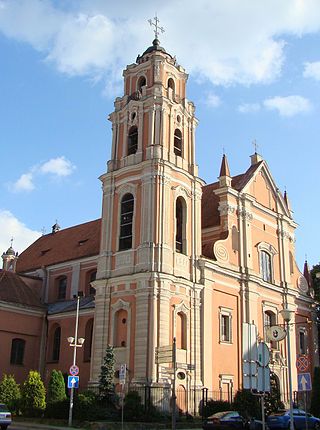
All Saints Church is a Baroque-style church in Vilnius, Lithuania. All Saints church was built between 1620 and 1630 and was adopted for Carmelites' needs. In the second half of the 17th century, the church was linked with a monastery and formed a single complex.
Vladas Drėma was one of the most prominent Lithuanian art historians, critics, and art conservation specialists. He is also a known artist. One of the most remembered publications of Vladas Drėma's is Dingęs Vilnius.
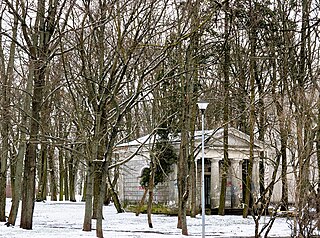
The Protestant Cemetery in Vilnius, Lithuania, was established in the early 19th century. As the city grew, there was a need to move the old Lutheran cemetery outside the city walls. The old cemetery, used from 1550s, was located on land donated by the Radziwiłł family on Liejyklos Street. Before the old cemetery was closed a professor of Vilnius University made an inventory of interesting tombstones. The list was acquired by Eustachy Tyszkiewicz and was stored in the Museum of Antiquities that he founded.
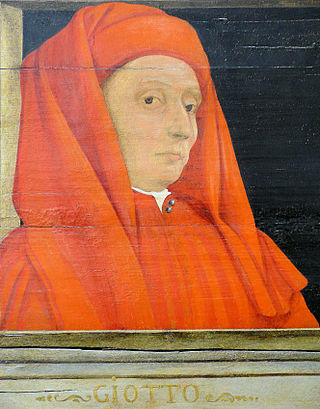
Giotto di Bondone, known mononymously as Giotto and Latinised as Giottus, was an Italian painter and architect from Florence during the Late Middle Ages. He worked during the Gothic/Proto-Renaissance period. Giotto's contemporary, the banker and chronicler Giovanni Villani, wrote that Giotto was "the most sovereign master of painting in his time, who drew all his figures and their postures according to nature" and of his publicly recognized "talent and excellence". Giorgio Vasari described Giotto as making a decisive break with the prevalent Byzantine style and as initiating "the great art of painting as we know it today, introducing the technique of drawing accurately from life, which had been neglected for more than two hundred years".

The Divine Mercy Sanctuary or the Holy Trinity Church in Vilnius is a shrine dedicated to the Divine Mercy, a devotion originated by Saint Faustina Kowalska.
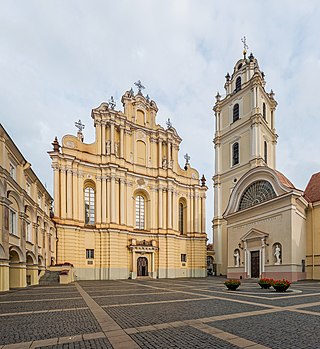
The Church of St. Johns, St. John the Baptist and St. John the Apostle and Evangelist is located at the Old Town of Vilnius, Lithuania and dominates the university ensemble. Since the times of the Jesuit Academy professors and students used to pray here, and Vilnius theologians gave sermons. It was a place for performances and disputes, where theses were defended and kings greeted.

The Church of St. Casimir is a Roman Catholic church in Vilnius' Old Town, close to the Vilnius' Town Hall. It is the first and the oldest baroque church in Vilnius, built in 1618.
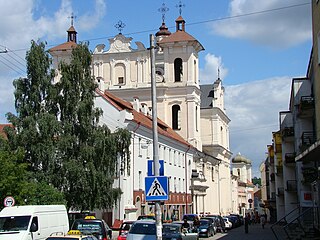
Dominican Church of the Holy Spirit, Vilnius is a church in Vilnius, Lithuania, a monument of high and late Baroque. Crowned with a cupola, it stands out in the panorama of the old town and can be seen from surrounding streets.

St Michael's Church or St. Michael the Archangel Church is a former Roman Catholic church in Vilnius' Old Town, on the right bank of the Vilnia River. It now hosts the Church Heritage Museum.

The Abbey of St. Peter in Assisi, Italy, is inhabited by a small community of monks belonging to the Benedictine Cassinese Congregation. They live according to the Rule of St. Benedict, summarized as "Ora et Labora".

The Franciscan Church in Brașov, Romania, is situated in the old town of Brașov at 7 Sf. Ioan street. It was built in Gothic style and underwent numerous changes during the Renaissance and later in the Baroque period. The church has been in the current form since 1711, hence the dominant Baroque style. It is dedicated to Saint John the Baptist.

The Bernardine Church of Our Lady Queen of Peace is a historic church from 1557, located in Bernardyńska street, in Bydgoszcz, Poland. Its patron was initially Saint George: in 1971, Polish primate Stefan Wyszyński changed its title to the current one.



















